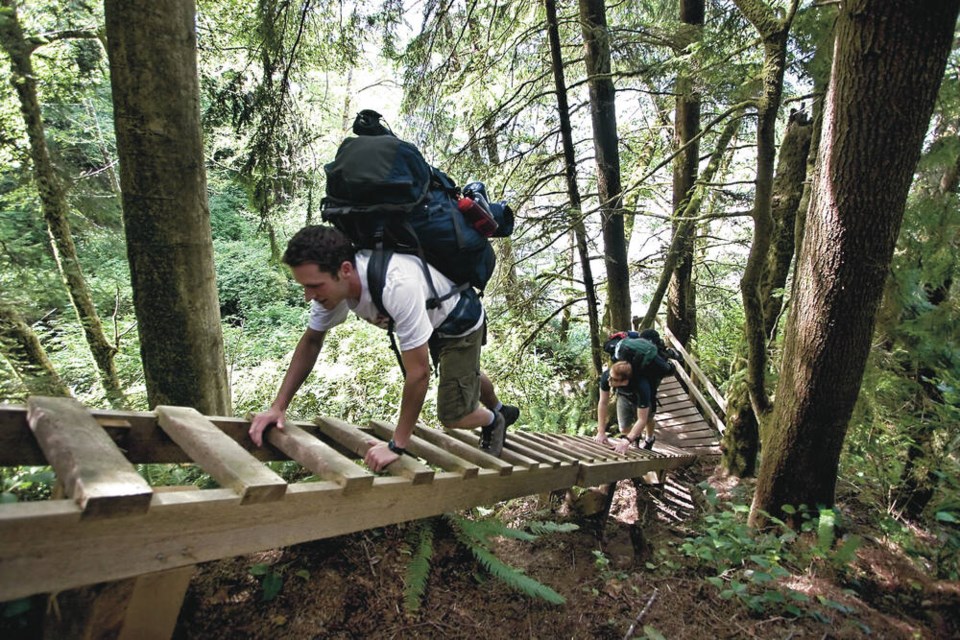For the second time in as many weeks, a medivac helicopter had to rescue a hiker from the West Coast Trail, a rugged, 75-kilometre route on the Island’s west coast.
On Tuesday, North Shore Search and Rescue used a helicopter with a 200-foot line to extract a woman who had slipped and fallen, dislocating her shoulder, said team leader Mike Danks. Another member of the hiking party was also lifted out, while two others stayed to finish the hike.
Danks said the search and rescue team arrived at the scene less than 40 minutes after the call. The agency uses five helicopters and has 45 members, including nine doctors on call.
The woman was airlifted to an ambulance in Port Renfrew and taken to Victoria General Hospital.
The rescue came two weeks after Edward Steinkamp of Texas slipped off a log on the trail and fell on a stick that rammed through his eye and pierced his brain.
After two surgeries, Steinkamp, an aeronautical engineer, remains in serious condition in Victoria General.
Danks said it’s shaping up to be a busy year for search and rescue crews on the trail.
“People are keen to get out there after the pandemic because the trail had been closed, so there’s a lot of demand.”
The West Coast Trail is a bucket-list trek for people close to home and around the globe but it’s no walk in the park. One false step along any part of the trail and hikers can find themselves in serious trouble.
Parks Canada says about one in every 75 hikers requires rescue during the May-to-September season due to slips and falls, as well as pre-existing medical conditions such as knee issues and heart conditions — or just plain exhaustion.
Nancy Hildebrand, spokeswoman for Parks Canada’s Coastal B.C. Field Unit, said last year, out of 6,559 people who hiked the trail during a shortened season, 56, or 0.86% of the total, had to be airlifted out because of exposure, exhaustion, injuries or illnesses.
Parks Canada says between 80 and 100 people on average are evacuated from the trail by sea or air every year, and about 200 hikers sustain minor injuries and manage to limp off the trail at one of the three trailheads.
Extractions are mainly done by boat and helicopter, though rough sea conditions often limit Parks Canada rescue efforts via water.
Air access is sometimes the only way to reach an injured hiker who needs help, said Hildebrand, noting most evacuations are done by Parks Canada visitor safety specialists by boat, although a serious or complex evacuation may require assistance from other agencies.
The West Coast Trail was closed in 2020 due to the COVID-19 pandemic and reopened a month shy of its usual start date last year, when 6,449 hikers hit the trail.
There were 8,087 hikers in 2019 and 7,930 in 2018, according to Parks Canada, which expects close to 10,000 hikers this year.
Hikers are being urged via social media posts to use extreme caution, especially this spring, when sections of the trail are proving to be wet and dangerous.
Corinne Adele Marshall, who finished a seven-day trek on Tuesday, said in a social media post that she was told at the midway point that 78 hikers had “bailed the trail” due to conditions.
She described the south end of the trail as “incredibly dicey,” with fallen trees, rains that turned the trail into a creek, and sticky mud bogs. Anything made of wood, such as stairs and bridges, feels like grease underfoot, she said.
“I started calling my movement penguining because that is what I literally had to do to prevent falls,” said Marshall.
Hildebrand said hikers are asked up front on the West Coast Trail website to assess whether it’s the right hike for them. Through a video and handbook, Parks Canada recommends that the trail only be attempted by seasoned backcountry hikers with multi-day trek experience.
“Even for experienced hikers, the hike is difficult, and slippery terrain, mud, ladders, creek crossings and cable cars are to be expected,” said Hildebrand.
“On top of this, you will be exhausted, wearing a heavy pack, and if you get injured, it could take up to 24 hours for help to reach you.”
Parks Canada is constantly repairing sections of the trail, but Hildebrand said infrastructure is at the mercy of frequent storms and wind events.
She said more than 330 centimetres of rain falls every year in the area, and washouts and mud pits are “natural features and part of the allure.”
In 2021, the Logan Creek Suspension Bridge was opened at Kilometre 56 of the trail. The 113-metre suspension bridge is one of the longest in British Columbia, and replaced an aging bridge and ladder system.
Hildebrand said Parks Canada prioritizes work on structures that pose the highest risks, noting repairs were recently done on cable cars and more than 30 bridges, and several kilometres of new boardwalks.
Indigenous West Coast Trail Guardians from Huu-ay-aht, Ditidaht and Pacheedaht First Nations, whose traditional territory includes the West Coast Trail, work each season to repair boardwalks, push back the lush rainforest plants and keep the trail passable.



